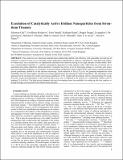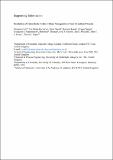Files in this item
Exsolution of catalytically active iridium nanoparticles from strontium titanate
Item metadata
| dc.contributor.author | Calì, Eleonora | |
| dc.contributor.author | Kerherve, Gwilherm | |
| dc.contributor.author | Naufal, Faris | |
| dc.contributor.author | Kousi, Kalliopi | |
| dc.contributor.author | Neagu, Dragos | |
| dc.contributor.author | Papaioannou, Evangelos I. | |
| dc.contributor.author | Thomas, Melonie P. | |
| dc.contributor.author | Guiton, Beth S. | |
| dc.contributor.author | Metcalfe, Ian S. | |
| dc.contributor.author | Irvine, John T.S. | |
| dc.contributor.author | Payne, David J. | |
| dc.date.accessioned | 2021-07-22T23:35:42Z | |
| dc.date.available | 2021-07-22T23:35:42Z | |
| dc.date.issued | 2020-08-19 | |
| dc.identifier | 269925558 | |
| dc.identifier | 4ed24518-8896-4255-b64e-f56c0c15954b | |
| dc.identifier | 85089768687 | |
| dc.identifier | 32698571 | |
| dc.identifier | 000563074900065 | |
| dc.identifier.citation | Calì , E , Kerherve , G , Naufal , F , Kousi , K , Neagu , D , Papaioannou , E I , Thomas , M P , Guiton , B S , Metcalfe , I S , Irvine , J T S & Payne , D J 2020 , ' Exsolution of catalytically active iridium nanoparticles from strontium titanate ' , ACS Applied Materials & Interfaces , vol. 12 , no. 33 , pp. 37444-37453 . https://doi.org/10.1021/acsami.0c08928 | en |
| dc.identifier.issn | 1944-8244 | |
| dc.identifier.other | ORCID: /0000-0002-8394-3359/work/79917723 | |
| dc.identifier.uri | https://hdl.handle.net/10023/23618 | |
| dc.description.abstract | The search for new functional materials that combine high stability and efficiency with reasonable cost and ease of synthesis is critical for their use in renewable energy applications. Specifically in catalysis, nanoparticles, with their high surface-to-volume ratio, can overcome the cost implications associated with otherwise having to use large amounts of noble metals. However, commercialized materials, that is, catalytic nanoparticles deposited on oxide supports, often suffer from loss of activity because of coarsening and carbon deposition during operation. Exsolution has proven to be an interesting strategy to overcome such issues. Here, the controlled emergence, or exsolution, of faceted iridium nanoparticles from a doped SrTiO3 perovskite is reported and their growth preliminary probed by in situ electron microscopy. Upon reduction of SrIr0.005Ti0.995O3, the generated nanoparticles show embedding into the oxide support, therefore preventing agglomeration and subsequent catalyst degradation. The advantages of this approach are the extremely low noble metal amount employed (∼0.5% weight) and the catalytic activity reported during CO oxidation tests, where the performance of the exsolved SrIr0.005Ti0.995O3 is compared to the activity of a commercial catalyst with 1% loading (1% Ir/Al2O3). The high activity obtained with such low doping shows the possibility of scaling up this new catalyst, reducing the high cost associated with iridium-based materials. | |
| dc.format.extent | 10 | |
| dc.format.extent | 1344850 | |
| dc.format.extent | 1420337 | |
| dc.language.iso | eng | |
| dc.relation.ispartof | ACS Applied Materials & Interfaces | en |
| dc.subject | Catalysis | en |
| dc.subject | Exsolution | en |
| dc.subject | in situ TEM | en |
| dc.subject | Iridium | en |
| dc.subject | Nanoparticles | en |
| dc.subject | QD Chemistry | en |
| dc.subject | Materials Science(all) | en |
| dc.subject | NDAS | en |
| dc.subject | SDG 7 - Affordable and Clean Energy | en |
| dc.subject.lcc | QD | en |
| dc.title | Exsolution of catalytically active iridium nanoparticles from strontium titanate | en |
| dc.type | Journal article | en |
| dc.contributor.sponsor | EPSRC | en |
| dc.contributor.institution | University of St Andrews. School of Chemistry | en |
| dc.contributor.institution | University of St Andrews. Centre for Designer Quantum Materials | en |
| dc.contributor.institution | University of St Andrews. EaSTCHEM | en |
| dc.identifier.doi | 10.1021/acsami.0c08928 | |
| dc.description.status | Peer reviewed | en |
| dc.date.embargoedUntil | 2021-07-23 | |
| dc.identifier.grantnumber | EP/R023522/1 | en |
This item appears in the following Collection(s)
Items in the St Andrews Research Repository are protected by copyright, with all rights reserved, unless otherwise indicated.


